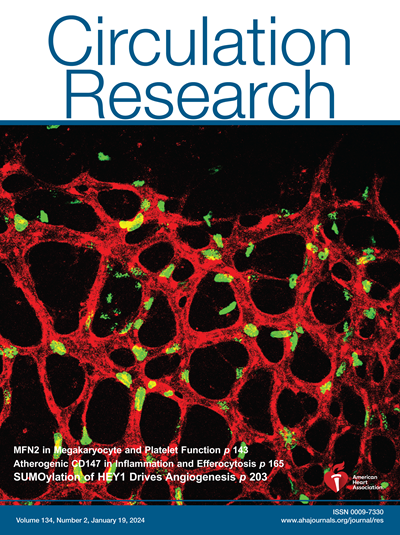GPR146 Facilitates Blood Pressure Elevation and Vascular Remodeling via PIEZO1.
IF 16.2
1区 医学
Q1 CARDIAC & CARDIOVASCULAR SYSTEMS
引用次数: 0
Abstract
BACKGROUND Hypertension is a prevalent chronic disease worldwide. Elevated hydrostatic pressure (HP) is the main feature of hypertension. GPCRs (G-protein-coupled receptors) are crucial for vascular tone and a significant pharmacological target for drug development. Here, we aimed to identify the key GPCR under high HP, and explore its role and mechanism in hypertension and vascular remodeling. METHODS First, RNA-seq was performed under high HP and identified the highly expressed GPCR-GPR146. Furthermore, global knockout GPR146 mice, vascular smooth muscle cell (SMC)-specific knockin and knockout GPR146 mice were used to explore its function in hypertension. Next, an HP loading system ex vivo was established to evaluate the role of GPR146 in response to HP. Vascular SMC-specific Piezo1 mice were constructed to investigate the relationship between GPR146 and PIEZO1. In vitro, GPR146-mediated downstream signaling transduction was detected by proximity ligation assay and bioluminescence resonance energy transfer. Finally, the therapeutic effect of hypertension was detected by GPR146 neutralization antibody injection. RESULTS Under high HP, we identified a highly expressed GPCR-GPR146 in vascular SMCs by RNA-seq and confirmed it in the arterial media of patients with hypertension and animal models. Functionally, overexpression or deletion of Gpr146 in SMCs demonstrated that GPR146 facilitated vascular contraction, promoted vascular SMCs phenotype switching from a contractile phenotype to synthetic phenotype and proinflammation phenotype, and led to blood pressure elevation, vascular remodeling, and cardiac hypertrophy aggravation. In vitro, GPR146 was upregulated in an HP-dependent manner. Mechanistically, GPR146 is a Gαs-coupled GPCR activating the cAMP-CREB1 (cAMP response element-binding protein 1) signaling cascade. Notably, GPR146 upregulated PIEZO1 expression by enhancing CREB1 binding to the PIEZO1 promoter region. Piezo1 deletion in SMCs blocked Gpr146-induced blood pressure elevation and vascular dysfunction. GPR146 neutralization antibody injection markedly alleviates angiotensin II-induced hypertension and vascular remodeling. CONCLUSIONS Collectively, GPR146 coupled with Gαs and activating the cAMP-CREB1-PIEZO1 signaling pathway contributes to hypertension and vascular remodeling. Blocking GPR146 is an effective therapeutic strategy for hypertension.GPR146通过PIEZO1促进血压升高和血管重构。
背景:高血压是一种世界范围内普遍存在的慢性疾病。静水压力升高是高血压的主要特征。gpcr (g蛋白偶联受体)对血管张力至关重要,也是药物开发的重要药理靶点。在此,我们旨在鉴定高HP下的关键GPCR,并探讨其在高血压和血管重构中的作用和机制。方法首先在高HP条件下进行rna测序,鉴定高表达GPCR-GPR146;此外,我们还利用GPR146全敲除小鼠、血管平滑肌细胞(SMC)特异性敲除和敲除GPR146小鼠来探讨其在高血压中的作用。接下来,我们建立了体外HP加载系统来评估GPR146在HP应答中的作用。构建血管smc特异性Piezo1小鼠,研究GPR146与Piezo1的关系。在体外,通过近距离结扎实验和生物发光共振能量转移检测gpr146介导的下游信号转导。最后通过注射GPR146中和抗体检测高血压的治疗效果。结果在高HP条件下,我们通过RNA-seq在血管SMCs中鉴定出高表达的GPCR-GPR146,并在高血压患者动脉介质和动物模型中得到证实。功能上,SMCs中Gpr146的过表达或缺失表明,Gpr146促进血管收缩,促进血管SMCs表型从收缩表型向合成表型和促炎症表型转换,并导致血压升高、血管重塑和心脏肥厚加重。在体外,GPR146以hp依赖的方式上调。从机制上讲,GPR146是激活cAMP- creb1 (cAMP response element-binding protein 1)信号级联的g αs偶联GPCR。值得注意的是,GPR146通过增强CREB1与PIEZO1启动子区域的结合来上调PIEZO1的表达。SMCs中Piezo1缺失可阻断gpr146诱导的血压升高和血管功能障碍。注射GPR146中和抗体可显著缓解血管紧张素ii诱导的高血压和血管重构。结论GPR146与Gαs偶联,激活cAMP-CREB1-PIEZO1信号通路,参与高血压和血管重构。阻断GPR146是治疗高血压的有效策略。
本文章由计算机程序翻译,如有差异,请以英文原文为准。
求助全文
约1分钟内获得全文
求助全文
来源期刊

Circulation research
医学-外周血管病
CiteScore
29.60
自引率
2.00%
发文量
535
审稿时长
3-6 weeks
期刊介绍:
Circulation Research is a peer-reviewed journal that serves as a forum for the highest quality research in basic cardiovascular biology. The journal publishes studies that utilize state-of-the-art approaches to investigate mechanisms of human disease, as well as translational and clinical research that provide fundamental insights into the basis of disease and the mechanism of therapies.
Circulation Research has a broad audience that includes clinical and academic cardiologists, basic cardiovascular scientists, physiologists, cellular and molecular biologists, and cardiovascular pharmacologists. The journal aims to advance the understanding of cardiovascular biology and disease by disseminating cutting-edge research to these diverse communities.
In terms of indexing, Circulation Research is included in several prominent scientific databases, including BIOSIS, CAB Abstracts, Chemical Abstracts, Current Contents, EMBASE, and MEDLINE. This ensures that the journal's articles are easily discoverable and accessible to researchers in the field.
Overall, Circulation Research is a reputable publication that attracts high-quality research and provides a platform for the dissemination of important findings in basic cardiovascular biology and its translational and clinical applications.
 求助内容:
求助内容: 应助结果提醒方式:
应助结果提醒方式:


